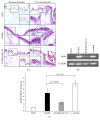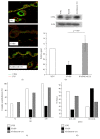The PDZ-Binding Motif of HPV16-E6 Oncoprotein Modulates the Keratinization and Stemness Transcriptional Profile In Vivo
- PMID: 29130045
- PMCID: PMC5654334
- DOI: 10.1155/2017/7868645
The PDZ-Binding Motif of HPV16-E6 Oncoprotein Modulates the Keratinization and Stemness Transcriptional Profile In Vivo
Abstract
Objective: The aim of this work was to compare the early gene expression profiles in the skin of HPV16-E6 transgenic mice regulated by the E6 PDZ-binding motif.
Materials and methods: The global transcriptional profiles in dorsal skin biopsies from K14E6 and K14E6Δ146-151 transgenic mice were compared using microarrays. Relevant genes obtained from the most differentially expressed processes were further examined by RT-qPCR, in situ RT-PCR, Western blot, or immunofluorescence.
Results: The transcriptomic landscape of K14E6 versus K14E6Δ146-151 shows that the most affected expression profiles were those related to keratinocyte differentiation, stem cell maintenance, and keratinization. Additionally, downregulation of epidermal stemness markers such as K15 and CD34, as well as the upregulation of cytokeratin 6b, appeared to be dependent on the E6 PDZ-binding motif. Finally, wound healing, a physiological process linked to stemness, is impaired in the K14E6 mice compared to K14E6Δ146-151.
Conclusion: The E6 PDZ-binding motif appears to affect stemness and keratinization during early stages of skin carcinogenesis. As E6 plays a significant role in HPV-induced skin carcinogenesis, the K14E6 versus K14E6Δ146-151 transcriptional profile provides a source of valuable data to uncover novel E6 functions in the skin.
Figures




Similar articles
-
The E6 oncoprotein from HPV16 enhances the canonical Wnt/β-catenin pathway in skin epidermis in vivo.Mol Cancer Res. 2012 Feb;10(2):250-8. doi: 10.1158/1541-7786.MCR-11-0287. Epub 2011 Dec 7. Mol Cancer Res. 2012. PMID: 22160870 Free PMC article.
-
Roles of the PDZ domain-binding motif of the human papillomavirus type 16 E6 on the immortalization and differentiation of primary human foreskin keratinocytes.Virus Genes. 2014 Apr;48(2):224-32. doi: 10.1007/s11262-013-1017-9. Epub 2013 Nov 29. Virus Genes. 2014. PMID: 24293186
-
The PDZ ligand domain of the human papillomavirus type 16 E6 protein is required for E6's induction of epithelial hyperplasia in vivo.J Virol. 2003 Jun;77(12):6957-64. doi: 10.1128/jvi.77.12.6957-6964.2003. J Virol. 2003. PMID: 12768014 Free PMC article.
-
Structure and function of the papillomavirus E6 protein and its interacting proteins.Front Biosci. 2008 Jan 1;13:121-34. doi: 10.2741/2664. Front Biosci. 2008. PMID: 17981532 Review.
-
The Human Papillomavirus E6 PDZ Binding Motif: From Life Cycle to Malignancy.Viruses. 2015 Jul 2;7(7):3530-51. doi: 10.3390/v7072785. Viruses. 2015. PMID: 26147797 Free PMC article. Review.
Cited by
-
MmuPV1-Induced Cutaneous Squamous Cell Carcinoma Arises Preferentially from Lgr5+ Epithelial Progenitor Cells.Viruses. 2022 Aug 11;14(8):1751. doi: 10.3390/v14081751. Viruses. 2022. PMID: 36016373 Free PMC article.
-
Human papillomavirus E6 and E7: What remains?Tumour Virus Res. 2021 Jun;11:200213. doi: 10.1016/j.tvr.2021.200213. Epub 2021 Feb 8. Tumour Virus Res. 2021. PMID: 33716206 Free PMC article. Review.
References
-
- Pfister H. Chapter 8: Human papillomavirus and skin cancer. Journal of the National Cancer Institute. Monographs. 2003;(31):52–56. - PubMed
MeSH terms
Substances
LinkOut - more resources
Full Text Sources
Other Literature Sources
Medical
Research Materials

